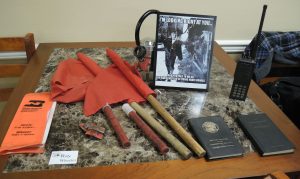Article and Photos by Rich Thom
The Skagit Valley & Whidbey Island NMRA Clinic held its final meeting of the season on May 11th at the Summerhill facility in Oak Harbor. Clinic Chair Rich Blake welcomed new member Mark Malmkar, who recently moved from Nebraska to Oak Harbor. Mark is a long-time model railroader (since age 10) and has a large HO layout, 14 by 40 feet (still in storage back in Nebraska), which models a passenger line passing through the Colorado mountains. We look forward to its reassembly and Mark’s first open house. Mark also has his own business manufacturing interior details for passenger cars; readers can find his range of products on-line at http://www.PalaceCarCo.com.
Clinic Newsletter-Master Al Frasch mentioned that he and Al Carter had colluded on a possible idea to have one joint meeting each season of the SV&W and Mount Vernon Clinics, at a location TBD. The thought resonated with attendees, so we’ll leave it to the two Als to flesh out the idea.
Rich then introduced the evening’s guest clinician, Ray Wheeler, who gave an informative (and in places, very amusing!) talk, The Lost Art of Railroad Hand Signals. Ray, a former Burlington Northern employee hiring on in 1971, combined demonstrations of commonly-used hand signals, two videos, and personal experiences, some of them best described as gritty, during his career.
The first video, covering some hand signal basics, was produced by Railtown 1897 State Historic Park. The second, a safety film produced by Great Northern titled “Why Risk Your Life?”, was entertaining not only for the motive power and rolling stock appearing in the film, but also for several stupid (even outlandish) moves by brakemen and other employees. Brakemen were shown crossing tracks in front of rolling boxcars without looking; hopping off cars without determining if their landing spot was level and safe; riding car sides and not paying attention to limited clearance locations, and so-on. This writer assumes the scenes were staged, but even to stage some of them looked dangerous!
In addition to demonstrating hand signals (Fig 1), Ray brought in some of the tools of the trade (Fig 2): flags, a lantern, fusees, a torpedo, timetable, rule books and a radio. Some comedians in the audience (our clinic has more than its share) encouraged Ray to demonstrate a torpedo, which no doubt would have been the highlight of the year for the residents and staff of our venue, the Summerhill senior residence, along with the first responders. By the way, this is a good place to mention the kindness and tolerance of our clinic hosts: it’s a great meeting room and the staff (and residents!) are always welcoming.
On a side note, the framed print in Fig 2 is a re-use of a movie promotion for one of Ray’s (and our) favorite films: Earnest Borgnine (pictured), as “Shack the brutal conductor”, duels with Lee Marvin in the rousing Emperor of the North Pole (1973). They just don’t make movies like that anymore.
Ray contrasted the training that newbie brakemen received “then”, compared to “now.” Then: essentially no more than OJT (on the job training), resulting in some rough first days, although one could sign on for student trips at one’s own expense. Now: six weeks of classroom training. Times have indeed changed.
Ray summed up the dangers of the job at one point: “Wheels and couplers show no mercy.”
Many thanks to Ray for making the sea voyage over to our islands and giving a thoroughly engaging and relevant talk.



No Comments Yet